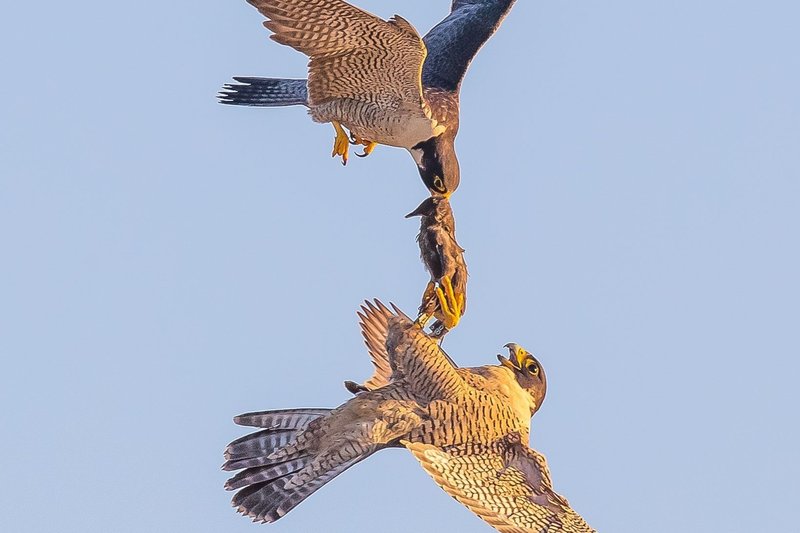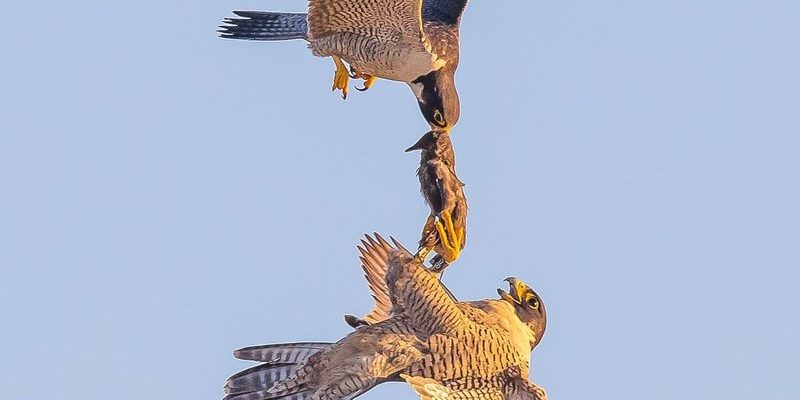
If you’ve ever seen a falcon in flight, you might have noticed its grace and speed. It’s fascinating to think about what drives their hunting behavior and what exactly they eat. So, let’s dive into the world of the Peregrine falcon, exploring its dietary preferences and the impressive tactics it uses to catch its dinner.
What Do Peregrine Falcons Eat?
Peregrine falcons have a pretty specific menu. They primarily feed on medium-sized birds, which might sound simple but is quite strategic. You might be wondering what kinds of birds are on their radar. Their top targets often include:
- Pigeons
- Sparrows
- Doves
- Songbirds
- Waterfowl
This broad range of prey shows their adaptability. Whether it’s the bustling city streets or the open countryside, these falcons have learned to thrive wherever their food sources are plentiful.
Interestingly, they prefer birds that are about the size of a starling or a pigeon. You could think of it as a menu that gets adjusted based on what’s available in their habitat. But hey, this isn’t a boring diet! Occasionally, they’ll also munch on small mammals like rabbits or even some insects. It’s all about seizing opportunities as they come.
Hunting Techniques of the Peregrine Falcon
Hunting is where the Peregrine falcon truly shines. Their style is nothing short of spectacular. Imagine being a bird that can fly at speeds of over 240 mph when diving! This ability makes them the fastest creatures on the planet. Here’s how they go about catching their meals:
1. Sight: One of the most striking features of the Peregrine falcon is its incredible vision. They can spot a tiny bird from miles away. This keen eyesight helps them track their prey’s movements before swooping in.
2. High Dives: Once the falcon has targeted a bird, it will aerially swoop down from a high perch. This dramatic dive, known as a “stoop,” allows them to harness gravity and gain tremendous speed. It’s like a roller coaster ride, but for a bird!
3. Impact: Upon catching up to their unsuspecting prey, they can strike with incredible force. This can be so powerful that it may kill the bird instantly. It’s a little brutal, but that’s nature for you.
Foraging Habits of Peregrine Falcons
Besides their high-speed hunting, Peregrine falcons also exhibit foraging behaviors that are a lot less dramatic. Sometimes, they’ll take advantage of their surroundings. Let me explain how that works:
– Urban Environments: In cities, they often perch on high buildings, waiting for flocks of starlings or pigeons. It’s like they’ve adapted to a new hunting ground full of unsuspecting snacks!
– Natural Habitats: In rural areas, they nest on cliffs or tall trees, scanning the skies. They know where to find their meals and how to be patient while waiting for the right moment.
– Scavenging: Though they prefer to hunt, they aren’t above scavenging either. If they see a dead bird, they might swoop down for an easy meal instead of making a big effort. Who wouldn’t grab a quick bite when they can?
Why Speed Matters in Hunting
Here’s the thing: speed is everything for the Peregrine falcon. It’s not just about being fast; it’s about being the fastest in the game. This speed gives them a huge advantage when hunting. Think about it—when you try to catch something, moving quickly allows you to cover ground before your target knows what’s happening.
– Avoiding Competition: With their speed, they can often catch prey before other predators, like eagles or hawks, even get a chance.
– Surprise Factor: The suddenness of their attacks catches unsuspecting birds off guard. It’s almost like a magic trick—one moment they’re free and flying, the next moment they’re darting down at incredible velocities.
This super speed isn’t just for show; it’s a critical aspect of their hunting strategy and is what makes them such successful predators.
Adaptations for Hunting and Eating
Peregrine falcons have also evolved several adaptations that make them exceptional hunters. Here are some fascinating features:
– Specialized Beak: Their beaks are sharp and hooked. This design makes it easier to tear into their prey quickly once they catch it. You can think of it like a pair of scissors designed specifically for meat.
– Strong Talons: Their feet are equipped with powerful talons that can grip and hold onto their prey tightly. This is essential when they’re diving at high speed and need to secure their meal before it gets away.
– Nictitating Membrane: This unique feature helps protect their eyes during those high-velocity dives. It acts like a protective shield, letting them see clearly without damage.
These adaptations work together seamlessly, making the Peregrine falcon not just a bird but a finely-tuned hunting machine.
Impact of Habitat on Diet
Where a Peregrine falcon lives significantly impacts its diet. You might think of it as a restaurant menu changing based on location.
– Coastal Regions: In these areas, their diet may include seabirds or ducks. Imagine a fisherman casting a line; the falcon is fishing for birds rather than fish.
– Urban Areas: Here, they often take advantage of urban-dwelling birds, including pigeons and starlings. Cities can be bustling environments, but they also provide ample hunting opportunities.
– Rural Landscapes: In the countryside, they might hunt across fields, targeting smaller birds or even small mammals. It’s like a buffet spread out across the land, and they know exactly how to get the best pick.
Understanding how their environment affects their diet gives us insight into their adaptability and survival.
The Importance of Prey Availability
Finally, let’s talk about prey availability. The success of Peregrine falcons, like any predator, hinges on how readily available their food sources are. This situation can be influenced by various factors:
– Urbanization: As cities grow, natural habitats shrink. This can reduce the population of certain birds, which might make it challenging for falcons to find enough food.
– Climate Change: Changes in weather patterns can affect bird migration and populations. If prey birds migrate earlier or later than usual, it can disrupt the hunting patterns of the falcons.
– Conservation Efforts: Thankfully, many conservation programs work to protect these magnificent birds and ensure that their habitats remain intact. The healthier the ecosystem, the healthier the falcon population.
Understanding these aspects can help us appreciate the delicate balance of nature and how critical it is to protect our wildlife.
As we wrap up this exploration into the Peregrine falcon’s diet and hunting prowess, it’s clear that this bird is a remarkable example of nature’s engineering. From its lightning-fast dives to its sharp beak and talons, every feature serves a purpose. Whether soaring through cityscapes or hunting in open fields, the Peregrine falcon remains a symbol of speed and precision in the animal kingdom. So, the next time you see one flying above, take a moment to admire not just its beauty but the incredible skills it employs to survive.

